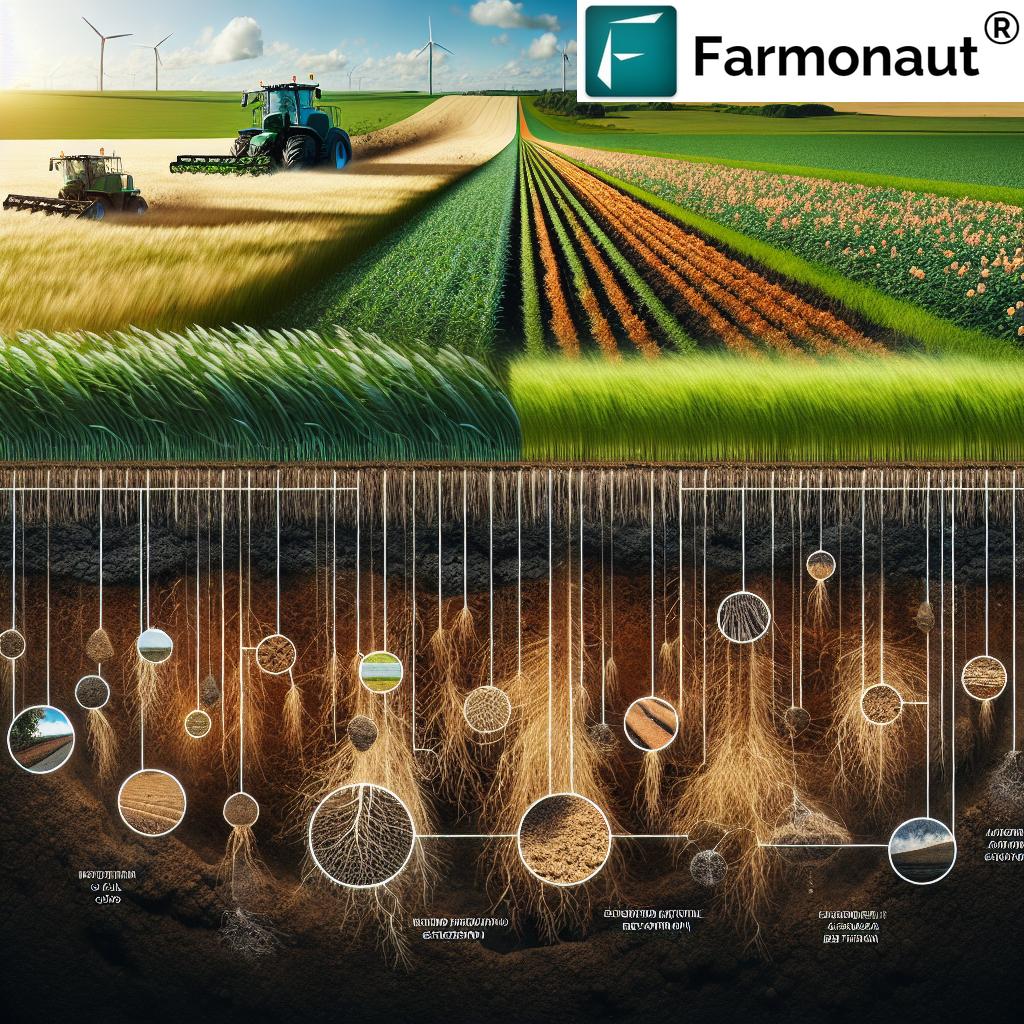USDA NRCS RIF Update: 5 Key Conservation Changes
Explore the crucial updates and far-reaching impact of the USDA Natural Resources Conservation Service’s initiatives under the Inflation Reduction Act (IRA). Dive into climate-smart agriculture practices, agricultural conservation funding, greenhouse gas reduction in agriculture, sustainable land management, and discover advanced private land conservation strategies for farmers, ranchers, and forest landowners.
“The USDA NRCS RIF update allocates over $19.5 billion for climate-smart agriculture and conservation through 2026.”
Table of Contents
- Understanding the Inflation Reduction Act & NRCS’s Role
- Key NRCS Conservation Programs under the IRA
- Fiscal Year 2024: Program Impact & Results
- Private Land Conservation Strategies: Achievements & Benefits
- Comparison/Impact Summary Table
- Workforce Challenges & Operational Impact
- Adopting Climate-Smart Agriculture & Sustainable Land Management
- How Farmonaut Empowers Conservation & Climate Resilience
- FAQ: Conservation, NRCS and IRA Updates
- Conclusion: The Future of Conservation, Funding, and Technical Assistance
Understanding the Inflation Reduction Act & NRCS’s Role in Conservation
The landscape of U.S. agriculture and conservation has experienced a transformation with the passage of the Inflation Reduction Act (IRA) in 2022. This sweeping legislation serves as a historic investment in climate resilience and sustainability, focusing extensively on reducing greenhouse gas emissions, advancing clean energy, and promoting conservation at scale.
At the core of these efforts is the Natural Resources Conservation Service (NRCS), the USDA agency leading the charge in implementing new conservation programs for farmers, ranchers, and forest landowners. The IRA channels close to $20 billion in agricultural conservation funding directly to the NRCS, empowering it to support climate-smart agriculture practices, carbon sequestration in farming, and environmental stewardship in agriculture.
- Focus: Reducing agriculture’s carbon footprint through technical, financial, and structural assistance.
- Goal: Support the adoption and implementation of innovative conservation measures, with an emphasis on greenhouse gas reduction in agriculture and climate resilience for producers.
- Legacy: Largest federal commitment ever for conservation, clean energy transition, and sustainable land management.
Key NRCS Conservation Programs under the IRA
The USDA, supported by the NRCS, has prioritized and expanded a cluster of key conservation programs aimed at delivering robust climate-smart agriculture practices. These initiatives drive agricultural conservation funding to address critical environmental challenges while offering meaningful incentives for farmers, ranchers, and landowners to adopt sustainable land management methods, enhance soil, water, and air quality, and elevate climate resilience.
Each program under the IRA is designed to strengthen the interaction between conservation incentives and on-the-ground implementation, while optimizing resource allocation.
1. Environmental Quality Incentives Program (EQIP): Improving Quality and Promoting Sustainability
The EQIP was infused with an additional $8.45 billion (over five years) to provide financial and technical assistance for landowners seeking to implement conservation practices addressing soil, water, and air quality. This program ranks among the most important in terms of yielding benefits for the environment and supporting agricultural producers seeking to reduce their environmental footprints.
- Assists willing producers—farmers, ranchers, forest managers—in implementing voluntary climate-smart conservation techniques.
- Supports improved resource use efficiency and enhances resilience against climate variability.
- Targets greenhouse gas reduction in agriculture, carbon sequestration in farming, and private land conservation strategies that enhance productivity and environmental outcomes.
EXAMPLE PRACTICES:
- Cover cropping, no-till, and conservation tillage—reduce erosion, improve soil health, and sequester carbon.
- Water management systems and advanced irrigation—preserve water resources and elevate operational sustainability.
- Nutrient management—minimize chemical runoff and safeguard air/water quality (environmental stewardship in agriculture).
2. Regional Conservation Partnership Program (RCPP): Collaboration and Strategic Investments
With an infusion of $4.95 billion, the Regional Conservation Partnership Program (RCPP) places emphasis on collaboration and partnership. It enables regional conservation priorities to be addressed by leveraging public-private partnerships. The program attracts significant investments and encourages large-scale adoption of conservation programs for farmers in diverse U.S. geographies.
- Fosters collaborative agreements across states, watersheds, and regions.
- Focuses on targeted, measurable outcomes—like reductions in nutrient runoff, improved habitat connectivity, and climate mitigation.
- Drives investment into eco-regional conservation priorities and resource restoration projects that amplify sustainable land management
EXAMPLE PARTNERSHIPS:
- Watershed-level floodplain restoration and wetland improvement initiatives.
- Large-scale forest management and reforestation campaigns.
3. Conservation Stewardship Program (CSP): Elevating and Maintaining Conservation Ethic
The CSP promotes a continuous spectrum of conservation improvements, with a sizable $3.25 billion IRA investment. It encourages producers to nurture existing conservation efforts and empowers them to adopt new ones, a key factor for sustainable agriculture and environmental stewardship in agriculture.
- Rewards landowners for high-level, ongoing sustainable management through annual payments and technical support.
- Supports a wide array of advanced conservation practices—from carbon sequestration to habitat improvement—that benefit overall farm operations.
- Promotes climate adaptation and resilience for producers through targeted incentives and innovation adoption.
EXAMPLE PRACTICES:
- Resource-conserving crop rotations and rotational grazing systems.
- Equipment upgrades for reduced soil disturbance.
4. Agricultural Conservation Easement Program (ACEP): Safeguarding Land for the Future
With $1.4 billion in additional funding, ACEP is central to protecting agricultural lands and wetlands through easements. The program enables landowners to voluntarily enroll in permanent or long-term conservation status, balancing economic and environmental priorities on private lands.
- Assists in preserving productive soils, wildlife habitats, and water filtration areas.
- Protects land from development or degradation, helping maintain agricultural viability and climate resilience for producers.
- Secures wetland, grassland, and forest conservation agreements.
5. Conservation Technical Assistance: Expanding Expertise and Delivery Capacity
The IRA directed $1 billion to strengthen technical assistance for landowners. This enables better outreach, planning, and on-farm implementation of innovative conservation practices and sustainable management technologies.
- Offers direct expert engagement to farmers and ranchers through field offices and digital platforms.
- Facilitates effective adoption of advanced strategies for soil health, water conservation, and climate-smart operations.
- Builds workforce skills for current and future conservation delivery.
Fiscal Year 2024: Program Impact & Record Participation
In 2024, USDA NRCS conservation programs experienced historic engagement and investment:
- EQIP: Nearly 9,000 applications, with requests totaling almost $475 million in funding—evidence of surging demand for conservation assistance and technical guidance.
- ACEP: Applications exceeded available funding by more than $180 million, proving widespread landowner interest in easement-based conservation.
- CSP: About 3,700 applications were received, all seeking to maintain and upgrade conservation measures beyond allotted resources.
- RCPP: Proposals surpassed $2 billion in funding requests, reinforcing the strong market for regional partnerships and innovative collaborations.
These numbers point to robust community support and lay the groundwork for transformative climate mitigation in agriculture and agricultural conservation funding across the United States.
“Greenhouse gas emissions from U.S. agriculture could drop by 10% with widespread adoption of new NRCS conservation practices.”
Private Land Conservation Strategies: Achievements & Benefits in Climate-Smart Agriculture
The influx of agricultural conservation funding under the IRA has helped the NRCS and, by extension, the entire agricultural community to make enormous gains in private land conservation strategies, greenhouse gas reduction in agriculture, and climate resilience for producers.
Key Impacts in 2024
-
Record Acreage Enrollment:
Over 23,000 climate-focused conservation contracts have been signed, covering upwards of 11 million acres of private and working lands—an NRCS milestone. -
Enhanced Climate Mitigation:
The implementation of climate-smart agriculture practices is significantly reducing greenhouse gas emissions while accelerating carbon sequestration in farming. -
Increased Landowner Participation:
Growing interest in programs such as EQIP, ACEP, and CSP reflects widespread acknowledgment of conservation’s business and ecological value.
Through these achievements, the USDA and NRCS demonstrate how new investments in environmental stewardship in agriculture carry tangible, data-backed benefits for producers, landowners, and the planet.
Comparison/Impact Summary Table: 5 Key Conservation Changes & Their Effects
| Conservation Change | Description | Estimated Funding Impact (USD) | Projected Greenhouse Gas Reduction (%) | Potential Benefits for Landowners |
|---|---|---|---|---|
| EQIP Expansion | Expanded technical and financial assistance for implementing conservation practices that improve soil, water, and air quality | $8.45 Billion (over 5 years) |
Up to 3–4% | Enhanced soil fertility, increased yields, cost-sharing for upgrades, reduced operational risk |
| RCPP Funding & Streamlining | Strengthened regional partnerships for collaborative conservation and large-scale resource restoration | $4.95 Billion | 1–2% | Access to shared resources, leveraged public-private funding, broader project reach |
| CSP Incentives | Annual payments and technical support for maintaining or enhancing high-level conservation activities | $3.25 Billion | 2% | Reward for stewardship, support for long-term land health, increased marketability |
| ACEP Easements | Financial and legal support for landowners to protect farmland and wetlands in perpetuity or long term | $1.4 Billion | 1–1.5% | Guaranteed conservation value, stable income, tax incentives, support for ecosystems |
| Technical Assistance Workforce | Expansion of NRCS and partner agents offering expert support and implementation resources | $1 Billion | Variable, indirect via implementation | Accessible expertise, easier program navigation, higher practice adoption success |
Workforce Challenges & Operational Impact: Meeting Demand for Conservation Programs
Despite record participation levels and significant capital flow, the NRCS faces substantial workforce challenges that could affect the implementation of the IRA and related conservation programs for farmers across the U.S.
- 2025 Workforce Reduction: In early 2025, a “workforce optimization” at USDA led to the termination of nearly 6,000 probationary employees, including those at NRCS. This has created urgency around maintaining technical support and hands-on guidance for landowners.
- Operational Risk: Staffing constraints can limit NRCS’s ability to process applications, deliver technical assistance, and sustain the ambitious pace of climate-smart agriculture practices.
- Mitigation Strategies: The NRCS is focusing on workflow efficiencies, streamlined digital resources, and prioritization of critical sustainable land management projects to ensure continuity.
Keeping the momentum alive will depend on investments in workforce training, digitized support services, and ongoing collaboration with local agricultural and conservation leaders.
Adopting Climate-Smart Agriculture & Sustainable Land Management: Practical Pathways
The robust investment in NRCS programs under the IRA unlocks powerful opportunities for farmers, ranchers, and forest owners to transition to climate-smart, sustainable models.
Core Climate-Smart Agriculture Practices
- Cover Cropping: Improves soil structure, reduces erosion, and traps atmospheric carbon—cornerstone of carbon sequestration in farming.
- Precision Irrigation and Water Management: Minimizes water loss, enhances yield consistency, and preserves water tables for future generations.
- Conservation Tillage & No-Till Farming: Protects soil biota, boosts moisture retention, and suppresses weed growth with minimal chemical intervention.
- Integrated Pest Management: Prioritizes biological and physical pest control over high-dose chemical use, protecting water quality and biodiversity.
- Riparian and Wildlife Buffer Establishment: Guards against runoff, supports pollinator populations, and increases on-farm carbon sinks.
Benefits for Landowners, Farmers, Ranchers & Producers
- Access to Funding: Direct financial assistance, cost-sharing, and resources for implementing new practices with lower personal risk.
- Resilience: Adaptation to erratic weather, market volatility, and fluctuating input costs through improved soil and ecosystem health.
- Market Advantage: Certified climate-smart crops, traceability, and carbon footprint tracking open doors to new supply chains and sustainability-conscious buyers.
- Soil, Air & Water Quality: Long-term conservation translates into reduced runoff, more productive soils, and cleaner local environments.
- Legacy and Stability: Programs like blockchain-based product traceability (offered by Farmonaut) create asset value, ensure farm viability, and preserve land for future generations.
How Farmonaut Empowers Conservation & Climate Resilience for Producers
At Farmonaut, we believe sustainable agriculture starts with actionable data and easy access to the latest technological solutions. Here’s how our platform amplifies the benefits of USDA NRCS’s conservation programs and IRA-driven climate-smart agriculture strategies:
-
Satellite-Based Crop Monitoring:
Our platform delivers real-time crop health assessments and soil moisture mapping, helping farmers proactively identify issues, optimize resources, and measure the impact of conservation investments. This supports efficient implementation of EQIP and CSP-funded practices and aligns with greenhouse gas reduction in agriculture. -
AI-Powered Advisory (Jeevn AI):
We offer instant, hyper-local advice on climate-smart agriculture practices, pest outbreaks, and more—enabling landowners to adapt and succeed regardless of evolving climate and regulatory challenges. -
Blockchain-Based Product Traceability:
Our traceability module gives producers secure, transparent digital proof of sustainable practices, boosting market confidence and regulatory compliance. -
Carbon Footprint Tracking:
Our carbon footprint module tracks and quantifies agricultural emissions, supporting projects that participate in carbon markets or aim for climate mitigation certification. -
Fleet & Resource Management:
Our GPS-enabled fleet management tools reduce emissions, save on input costs, and safeguard field operations in partnership with conservation guidelines and regional environmental standards. -
APIs for Custom Integration:
Leverage powerful satellite and climate data directly in your system with our API and developer resources.
Our solutions are designed for producers, cooperatives, researchers, and agribusinesses committed to maximizing environmental stewardship in agriculture. For those managing large acreages or diverse crops, we offer a tailored large-scale farm management platform with the same mission: increase productivity, ensure compliance, and build a better climate future.
Getting Started with Farmonaut
Sign up for an affordable subscription to unlock satellite farm monitoring, AI-powered advisories, carbon tracking, and more—no specialized hardware required.
FAQ: Conservation, NRCS and IRA Conservation Funding Updates
1. What role does the NRCS play in climate-smart agriculture?
The NRCS leads the planning, delivery, and support of climate-smart agriculture practices by providing financial and technical assistance to implement soil, water, habitat, and air quality improvements. The agency guides farmers and landowners in making long-term, sustainable land management decisions.
2. How do conservation programs help reduce greenhouse gas emissions in agriculture?
Conservation programs under the IRA—such as EQIP, RCPP, CSP, and ACEP—encourage producers to adopt practices that enhance soil health, reduce fertilizer use, store carbon, and improve resource efficiency. These efforts directly reduce agriculture’s greenhouse gas emissions and foster climate resilience.
3. What are the most impactful practices for climate mitigation?
Cover cropping, reduced/no-till farming, improved nutrient management, wetlands restoration, and rotational grazing are among the most effective approaches for carbon sequestration, soil health, and sustainability.
4. How can technical assistance benefit landowners?
Technical assistance from NRCS experts provides guidance on practice selection, design, and implementation—greatly increasing the success and sustainability of conservation efforts while making enrollment and compliance easier for all landowners.
5. Can Farmonaut help with conservation planning and carbon tracking?
Yes! Our satellite and AI-enabled tools offer real-time visibility into crop health, resource use, and outcomes of conservation practices; while our carbon footprinting module enables tracking and improvement of on-farm greenhouse gas emissions.
Conclusion: The Future of Conservation, Funding, and Technical Assistance
The USDA NRCS RIF update and the IRA together mark a new chapter in U.S. agriculture’s commitment to conservation, resilience, and sustainability. With innovative programs, robust funding, and a clear focus on climate mitigation, carbon sequestration in farming, and private land conservation strategies, the future for American farmers, ranchers, and forest owners promises not only productivity but also environmental stewardship in agriculture.
Despite persistent challenges—especially workforce constraints and surging demand—the foundation is set for transformative change. By implementing climate-smart agriculture practices and utilizing new technical resources, landowners will be better positioned than ever to improve yields, reduce emissions, and leave a lasting legacy of sustainability.
At Farmonaut, we stand ready to provide producers, researchers, and agribusinesses with affordable, state-of-the-art technology for every step of this journey. Explore our apps, API services, carbon monitoring, traceability modules, and more—empowering you on the path toward a sustainable, climate-smart agricultural future.
For more resources and to start your farm’s journey to sustainability, visit our web and mobile app today!






















